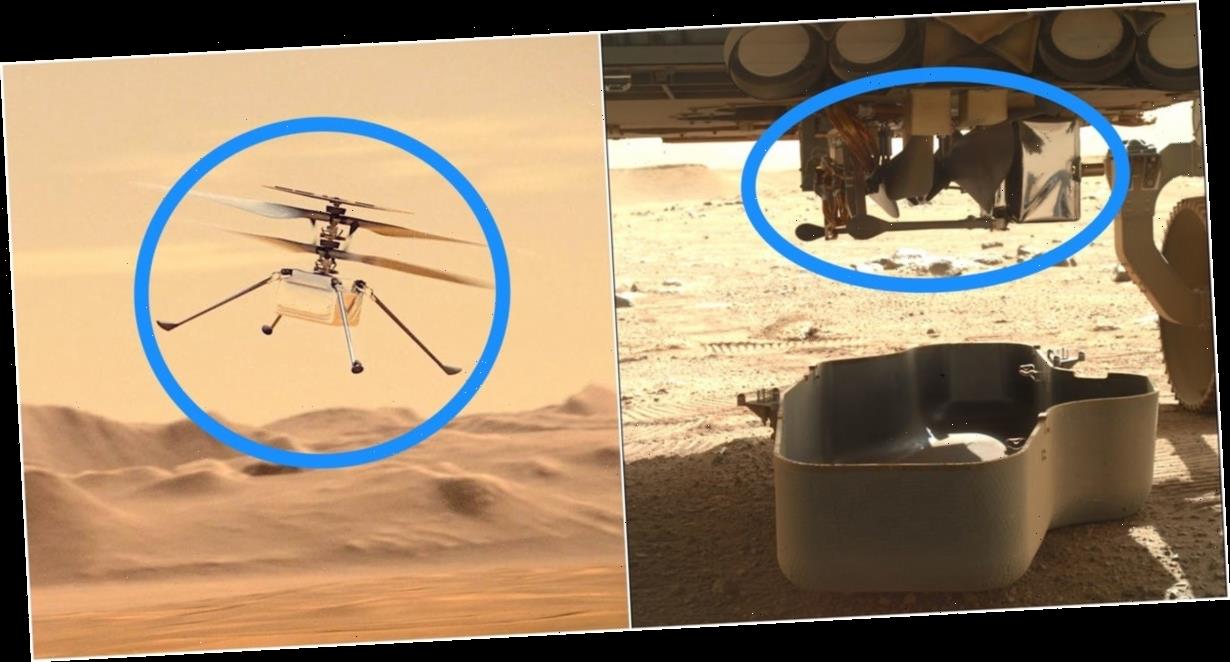- NASA’s Perseverance Mars rover has revealed the helicopter attached to its belly, called Ingenuity.
- The drone is set to fly up to five times on Mars, pioneering a new space-exploration technology.
- Perseverance is en route to the airfield where it will release the helicopter.
- See more stories on Insider’s business page.
NASA’s Perseverance rover is almost ready to drop a helicopter from its belly.
The $85 million, four-pound rotocraft, called Ingenuity, could pioneer a new approach to exploring other planets. As a technological demonstration, the drone is set to conduct up to five test flights on Mars starting as early as April 8.
The rover and its helicopter stowaway have already begun their journey to an open Martian plain that will serve as an airstrip. On Sunday, Perseverance dropped the guitar-shaped shield that was protecting the helicopter, exposing Ingenuity to Martian air for the first time.
A camera on the rover captured the drone folded up against its belly. Ingenuity will soon unfold itself — a process NASA has called “reverse origami” — and attempt the first controlled flights on another planet.
“We use drones and helicopters, here on Earth, for all sorts of things that they’re more suitable for than land-based vehicles,” Håvard Grip, NASA’s chief pilot for Ingenuity, said in a press briefing on Tuesday.
On other planets, the thinking goes, similar aerial explorers could do all kinds of things rovers can’t.
“That could be for reconnaissance purposes — taking pictures to scout out areas, potential science targets for future rovers, or even future astronauts on Mars,” Grip said. “Or it could be carrying its own science instruments into areas where you can’t get with a land-based vehicle.”
Ingenuity’s mission is to demonstrate that this new kind of spaceflight works. So in the next few weeks, the drone must unfold itself, drop from the rover’s belly, survive frigid Martian nights, and fly in the thinnest atmosphere any rotocraft has ever attempted.
Ingenuity must survive a short drop and freezing Martian nights
NASA announced on Tuesday that the Ingenuity team has picked out an airfield: a 33-by-33-foot patch of flat land near Perseverance’s landing spot. From there, Ingenuity can safely lift off and land, with a roughly 300-foot-long flight zone to explore in the air.
Once Perseverance reaches the airfield, it will spend six days maneuvering the helicopter into place, allowing it to unfold itself. Then it will drop Ingenuity the last 5 inches to the ground.
“The most stressful day, at least from for me, is going to be that last day when we finally separate the helicopter and drop Ingenuity on the ground,” Farah Alibay, who leads the team in charge of the helicopter’s integration into Perseverance, said in the briefing.
That’s because Perseverance has to back away quickly, exposing the helicopter’s solar panels so they can charge. That will be critical, since Mars’ surface temperatures at night dip as low as negative 130 degrees Fahrenheit. Ingenuity can only survive one night in those intense conditions without filling up on solar power.
After its first charging session, Ingenuity will spend about a week testing its sensors and motors. If everything is in working order, it will finally be ready to fly.
A month of helicopter flights on Mars
Because communicating with spacecraft on Mars takes a few minutes from Earth, ground controllers can’t direct Ingenuity’s flight in real time. So engineers have designed and programmed the helicopter to carry out up to five flights autonomously, within a span of 30 Martian days (roughly one Earth month).
Mars has an incredibly thin atmosphere — just 1% the density of Earth’s. To catch enough air, the helicopter’s four carbon-fiber blades have to spin in opposite directions at about 2,400 revolutions per minute — about eight times as fast as a passenger helicopter on Earth.
“I think the biggest challenge will be that we are flying in the atmosphere of Mars, which has its own dynamics, its own winds, wind gusts, and so forth,” Bob Balaram, NASA’s chief engineer for the helicopter, said in the briefing. “These are things which we tested with wind tunnels in our chamber. We have some confidence that everything will be good. But there’s nothing that beats actually being in the real environment of Mars to see how well the flight and aerodynamics actually works out.”
Ingenuity’s first flight will just test whether the helicopter can successfully get a few feet off the ground, hover for about 30 seconds, then touch back down. From there, each test will get more difficult than the last, culminating in a final flight that could carry the helicopter over 980 feet (300 meters) of Martian ground.
Even one short flight would be a major achievement.
“It will be truly a Wright Brothers moment, but on another planet,” MiMi Aung, project manager for the helicopter team, said in a briefing before the rover landed. “Every step going forward will be first of a kind.”
After Ingenuity finishes its flights, Perseverance will begin its main mission: driving across a former river delta and searching for signs of ancient alien microbes.
Source: Read Full Article
